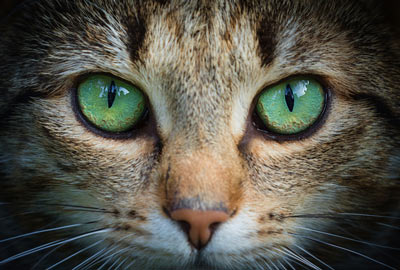Rabies in Cats

Rabies is a virus that infects warm-blooded animals. Cats, dogs, and humans can all be infected by this dangerous virus.
Facts About Rabies
Here are some interesting facts that it is important to know about rabies:
- Rabies can infect any mammal, but some are more resistant to it than others. Rodents like squirrels, mice, and rats rarely get rabies and have not been known to transmit it to humans.
- Raccoons, skunks, bats, opossums, and foxes are all common wild carriers of rabies that can transmit the disease to cats or humans.
- Bait laced with oral rabies vaccine is used to vaccinate wildlife in many areas, decreasing the virus' spread.
- There are an average of 3 human deaths per year from rabies in the United States.
-
Most human cases of rabies have been caused by bats, but less than 1/2 of 1% of bats carry the virus.
- Some countries in the world are rabies-free. These are mostly islands and includes the United Kingdom, Australia, Japan, and Iceland.
- Rabies virus spreads through saliva, and it doesn't live long in the environment.
How Does Rabies Spread?
Rabies is spread through the saliva of infected animals. Bite wounds in which saliva is deposited under the skin of the victim are the primary way that rabies is transmitted.
Cats are usually infected by wildlife, and it is more common for outdoor cats to contract it than indoor ones. One exception is when rabid bats gain entrance into a home.
Signs of Rabies
Once infected, the virus incubates for a while in the body before it causes signs. This incubation period may last anywhere from 10 days to several years.
In cats, the incubation period is usually 3-8 weeks. Once clinical signs begin, death occurs within 10 days.
Signs of rabies are neurologic because the central nervous system is attacked by the virus. Here are some of those signs:
- Behavior changes such as agitation, aggression, nervousness, or shyness are the hallmark of rabies.
- Pupils that are extremely dilated are seen throughout the course of the disease.
- Agitation worsens during the "furious stage" of the illness, and the cat may become irritable, hyperactive, and attack easily.
- Paralysis of the throat muscles causes the cat to stop eating and drool excessively.
- Eventually, the cat becomes paralyzed, then comatose, and then death occurs.
Diagnosis of Rabies in Cats
Diagnosis of rabies can only be done by examining brain tissue microscopically. That means that there is no test that can be done on a live animal to verify rabies.
In cases where rabies is strongly suspected or the law requires testing because a human has been bitten, the cat will need to be euthanized so the brain can be examined.
Treatment of Rabies
There is no treatment for rabies in cats. It is virtually always fatal once clinical signs begin.
In humans, it is possible to keep an infected person from developing rabies by vaccinating them prior to the point in the illness at which the virus enters the nervous system.
If a cat bites a person, there are laws to follow regarding what should be done. These vary by state, but generally, if the cat's rabies vaccination is current, a booster vaccine may be given and the cat observed for a period of time for any unusual signs. If the cat is not vaccinated, euthanasia and testing for rabies may be required, or sometimes, strict quarantine and monitoring for signs for varying periods of time is allowed.
Your local veterinarian is best suited for providing you with specific information for your area, and you can also visit this website for state-by-state requirements for vaccination and protocols for exposure or human bites: www.rabiesaware.org
Prevention of Rabies
Although the occurrence of rabies in people is low, it is a fatal illness, so it's important to take every precaution possible to avoid it. Here are some things to keep in mind:
- Never approach or handle wild animals.
- Contact your local animal control if you see wildlife that appears sick or injured; don't try to help the animal yourself.
- If you, your pet, or someone you know is bitten by a wild animal, seek immediate medical care.
- If you find a bat in a room where someone is sleeping, that person should be assumed to have been bitten, and immediate medical attention and rabies vaccination are warranted.
- Never handle a dead wild animal without gloves. The saliva of a rabies-infected animal may remain infective for a short time.
- Have your pets vaccinated against rabies. Wide-spread vaccination of pets and wildlife is the single best way to slow the spread of rabies and to protect humans from the virus. Even if rabies vaccination is not required by law in your state, having your cat vaccinated and boosters done when required is critical to keeping your cat and your family safer.
You May Also Like These Articles:
FIV: Feline Immunodeficiency Virus
Cat Scratch Fever: What It Is and How to Avoid It
FIP: Feline Infectious Peritonitis in Cats
FIV: Feline Immunodeficiency Virus
Bubonic Plague: Cats are Highly Susceptible
Notice: Ask-a-Vet is an affiliated service for those who wish to speak with a veterinary professional about their pet's specific condition. Initially, a bot will ask questions to determine the general nature of your concern. Then, you will be transferred to a human. There is a charge for the service if you choose to connect to a veterinarian. Ask-a-Vet is not manned by the staff or owners of CatHealth.com, and the advice given should not delay or replace a visit to your veterinarian.






